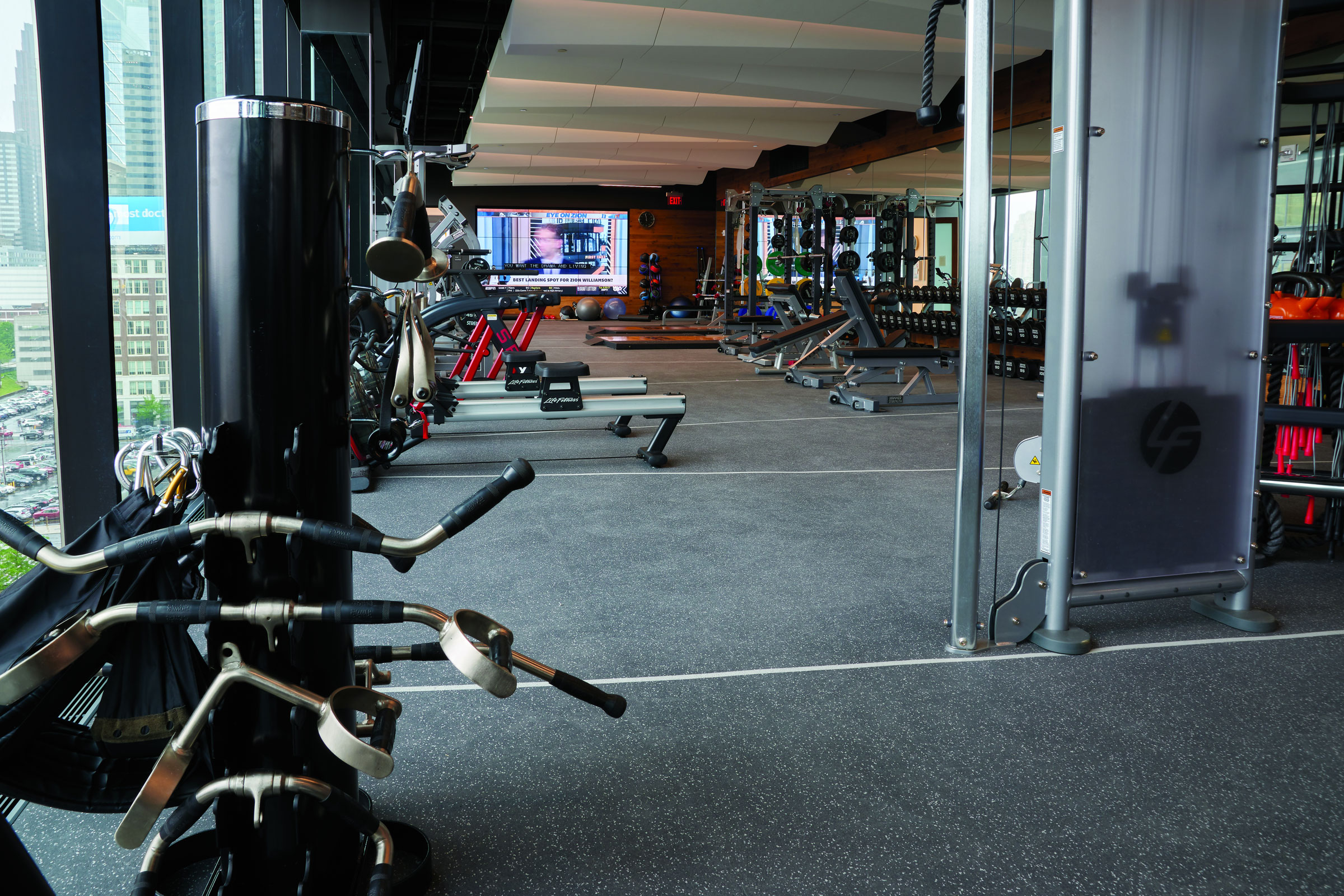Story at a glance:
- The REGUPOL sonusfit range combines sports and acoustic performance with effective vibration isolation, sound dampening, and spring properties.
- Gensler turned to REGUPOL when a new office fitness center they were designing needed high-quality rubber sports flooring.
For nearly 70 years REGUPOL has been providing the industry with innovative acoustic flooring solutions for commercial flooring projects, sports and fitness facilities, and more.
The leading acoustics company has extensive experience in impact and airborne sound insulation and works closely with architects and building professionals to ensure comfortable, whisper-quiet spaces. The family-run business is now being led by the third and fourth generations of family members who know the presence of unwanted noise or vibration can be debilitating.
We recently talked with REGUPOL’s Wil Younger to learn more about the company’s sports and acoustic flooring expertise and how they produce a superior, sustainable result.
How are REGUPOL’s sports and acoustics divisions working to create the best flooring?
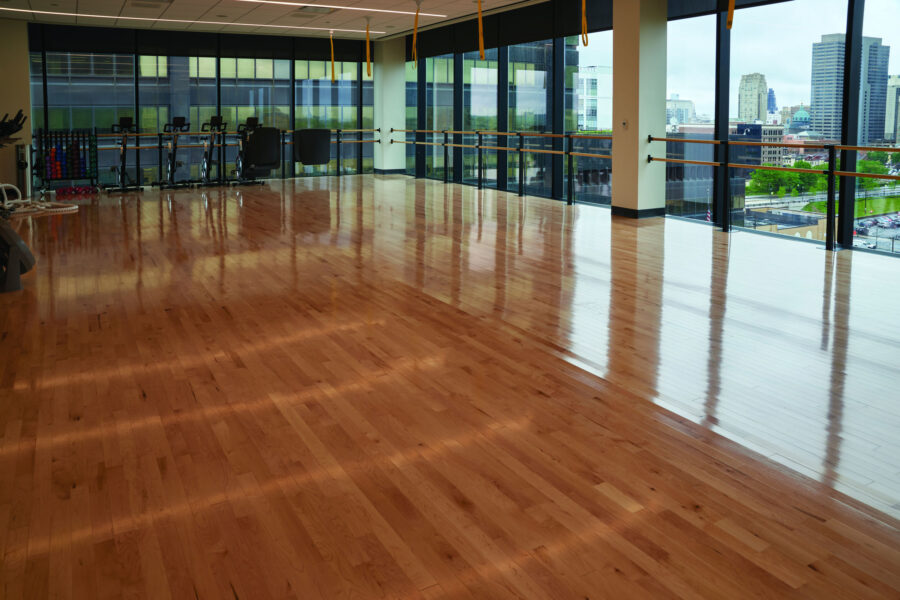
Photo courtesy of REGUPOL
Fitness environments are often associated with noise. Dropped free weights, pounding cardio equipment, and energetic group training can all contribute to extensive impact sound and vibration. Combined with a growing movement to integrate fitness amenities within mixed-use buildings and multi-family dwellings, this noise isn’t just a problem for those within the facility. It becomes a concern for occupants throughout the building as well as those in close proximity.
This makes proper acoustical sports floor systems critical to occupant wellness and building performance. At REGUPOL we tailor sound insulation designs to each application based on its type, scope, intensity, and building structure. Our acoustical underlayments are then topped with our proven sports flooring to achieve safety and comfort underfoot while also enhancing athletic performance.
How do your sports floor solutions have acoustic benefits?
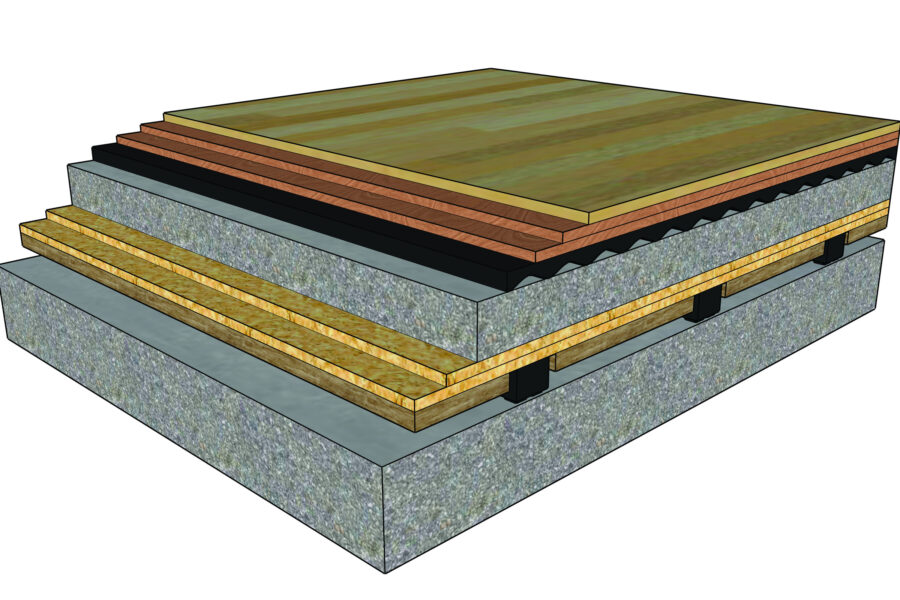
The REGUPOL sonusfit range has been acoustically tested and can be adapted accordingly to the different loads that occur in gyms. Image courtesy of REGUPOL
The REGUPOL sonusfit range was designed specifically to address combined sports and acoustic performance. The multi-layer system incorporates various densities of elastomers to achieve effective vibration isolation, sound dampening, and spring properties. This creates an optimal training surface when extreme sound proofing and shock absorption are necessary.
Can you share an example of this in action?
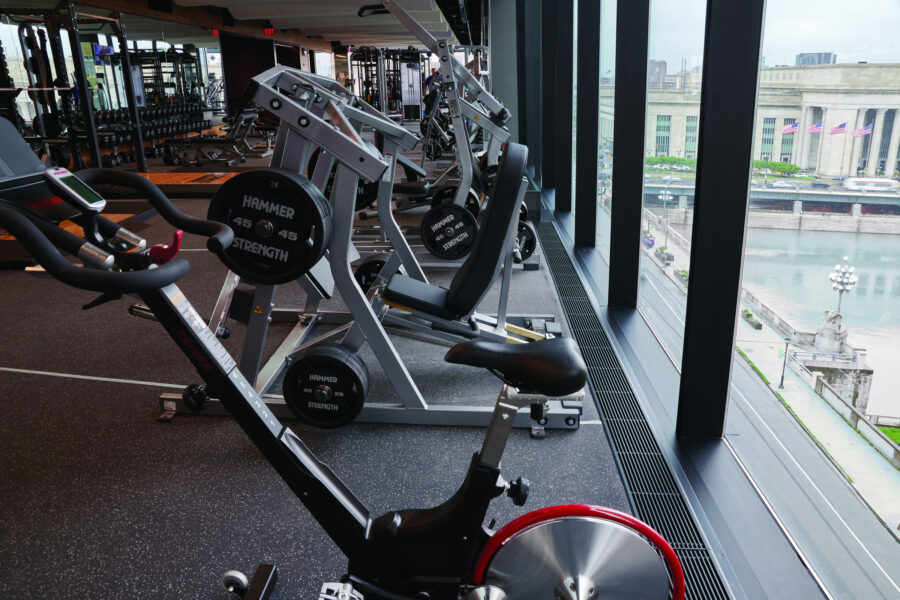
Photo courtesy of REGUPOL
Gensler designed an office-friendly fitness center using REGUPOL flooring. The architecture firm ultimately chose the REGUPOL sonusfit m520 (formerly AkustiPro ML70) coupled with a floating floor system supported by the REGUPOL soundpanel.
The REGUPOL sonusfit m52 is a PUR bonded system consisting of a dense wear layer for enhanced stability and high damping components that reduce vibration, particularly in the low-frequency range. The REGUPOL soundpanel is a panelized free-floating subfloor system designed to absorb airborne sound and dissipate structure-borne vibration. When used together the system provides unmatched performance.
In the end the client was very pleased with their new wellness center. They’re able to use all of their equipment without the worry of disturbing their coworkers in nearby offices, as low-frequency noise and vibration created by heavy impacts have been reduced to minimal levels.
The finished product is aesthetically pleasing, too. The finish flooring features the REGUPOL Thunder Gray with custom solid light-gray inlays in the weight room and a beautiful hardwood finish in the multipurpose room.
How have acoustic solutions evolved in fitness facilities?

Whether it’s a cardio area, freeweights, or Crossfit, REGUPOL sonusfit is designed to reduce sound and vibration transmission effectively. Image courtesy of REGUPOL
Requirements for noise reduction are particularly complex within fitness facilities for two reasons: the wide range of training methods and noise sources that are typical in a gym environment, and because there is currently not a standard test method for acoustical measurements under typical gym conditions.
When our team began engineering sonusfit, we knew we would need to replicate real-world conditions like the drop of dumbbells, barbells, and kettlebells from various heights and angles, to establish efficacy. To ensure the reproducibility of measurements and comprehensively represent the most diverse noise sources, we first constructed a dropping machine that could lift various weights at a height of six-and-a-half feet. Using this application-oriented and reproducible measurement process we are now able to effectively conduct in-house product tests that replicate a variety of fitness applications.
How has the demand for acoustic solutions changed in general?
The demand for acoustic solutions has remained on a steady incline in recent years driven by urban densification, the rise of mass timber, and an increased awareness of the detrimental impacts mismanaged sound can have on human health.
The United Nations predicts that nearly 70% of the global population will live in urban cities by 2050. Because of this cities are becoming more densely populated and developers are expanding vertically and building above existing buildings to accommodate this influx of people. Proper acoustics are critical to reducing impact sound between adjoining units and to mitigate low-frequency structure borne-noise. Additionally, vibration from building amenities like gyms, pools, or parking structures must be addressed. Vibration from building equipment and nearby transportation infrastructure are also sources of sound that affect residents.
The rise of mass timber construction presents an excellent option to advance low-carbon building, however these structures often possess unique acoustic challenges—especially within the low frequency range.
Additionally, several organizations have begun to place a greater emphasis on acoustic standards driving awareness for the harmful effects of poorly managed building noise. WELL building standards cite sound management as a critical component in promoting occupant health and well-being. And the release of LEED v4.1 placed greater value on acoustic performance within data centers, warehouses, health care facilities, and schools with an emphasis on reducing sound transmission and mitigating HVAC vibration and background noise.
What should architects consider before specifying fitness flooring?
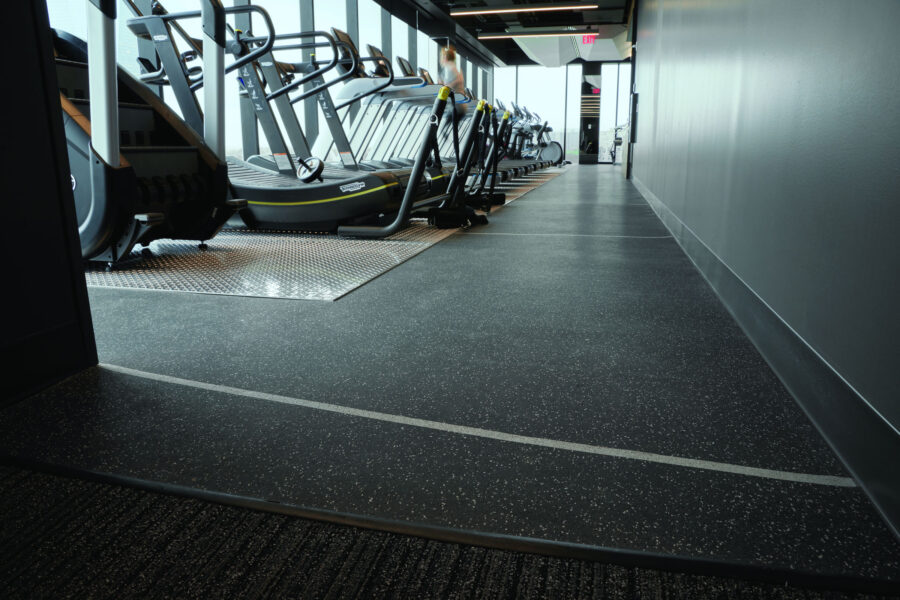
Photo courtesy of REGUPOL
Functionality and usage of the space should always be the first consideration when designing a fitness center or weight room. When we know how the space will be used and can define the applications that will take place, we can make the right flooring recommendation for these types of spaces. This should include attention to impact sound, vibration, foot traffic, potential rolling loads, and comfort and safety underfoot. Aesthetics and maintenance are other factors that will also inform product selection as long-term performance and satisfaction.
Where might architects consider these solutions?
The product’s long life cycle, performance, and affordability make it an attractive option for virtually any gym environment—from weight training to cardio machine areas, group fitness, sports courts, and even climbing areas.
Our broad color range and ability to customize designs, patterns, and logos also make REGUPOL sports flooring ideal for enhancing reception and social areas.
What else do people need to understand about rubber sports flooring?
The misconception that we run into most frequently is that all rubber sports flooring is the same. That could not be further from the truth. As the inventor of recycled rubber flooring technology we’ve mastered the formulation, quality, and consistency necessary to provide long-term performance and resiliency. And we’re testing these products in the most extreme environments to ensure they can withstand the most challenging conditions with minimal maintenance.
It’s often alluring to focus on a solution that offers a cheaper upfront cost, but often those options will result in costs overtime and may not be the most environmentally conscious products.
What acoustic flooring solutions should be considered in retrofits?
The key to building sustainable cities is intelligent densification, efficient use of existing buildings, and the conservation of finite resources. Increasing the renovation rate rather than constructing new buildings is an important factor in the efforts of cities and municipalities to achieve ecological and economic goals.
Old buildings often do not provide energy-efficient structures or sufficient sound control. In contrast, more and more cities aim for increased sustainability and better living quality. This has led to a need for increased energy efficiency and acoustic insulation measures. At the same time architects, developers, and consultants are facing other challenges like limited floor heights and lightweight structures.
REGUPOL core or REGUPOL sonus curve floor underlayments take up minimal space and greatly contribute to noise reduction and the improvement of quality of life. Additionally, REGUPOL sonusclips efficiently reduce noise through wall and ceiling assemblies meeting even the most stringent acoustical requirements.
How is REGUPOL a sustainable company?
We are passionate about advancing sustainability through circularity. It’s the driving force behind our product development and what has enabled us to become one of the world’s leading processors of recycled elastomers.
How do recycled elastomers lead to better flooring?
The characteristics of recycled elastomers are highly resilient and can achieve a multitude of performance qualities, including vibration isolation, sound dampening, shock absorption, slip resistance, and comfort—elements necessary for successful fitness facility design.
How are REGUPOL’s products made?
Our products are comprised of up to 95% recycled content either from shredded and cleaned SBR tire rubber (100% post-consumer waste) or a combination of SBR tire rubber and vibrant EPDM color granules (post-industrial waste). The entire manufacturing process is environmentally responsible using minimal water, avoiding heat, and recycling waste.
Many of our products can be salvaged and returned to REGUPOL for recycling at the end of the building life cycle. In fact, many of our acoustic products have earned the Cradle to Cradle Certified Bronze Level certificate because of their circular product cycle.
These factors not only help protect the environment, they can help architects and facility managers achieve decarbonization goals and many products can contribute to LEED certification.
How has the company’s commitment to sustainability evolved?
Sustainability has been at our core since REGUPOL was founded in 1954. Each year we reclaim more than 9 million tires from landfills to make these environmentally sound solutions. This process is regularly monitored by our energy team to ensure continuous energy efficiency and responsible use of materials.
As the world moves toward aggressive and necessary sustainability goals, our team has taken leadership roles in working with business leaders, educational institutions, and legislation to emphasize the importance of a circular economy including advisory roles with AZuR, a forum for waste tire recycling and Initiative New Life, a leader in recycling end-of-life tires. Additional certifications include GreenCircle Certified, USGBC members, MindfulMaterials, and UL-listed/certified EPD.

